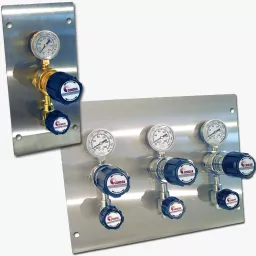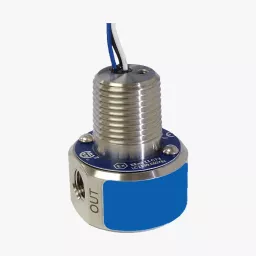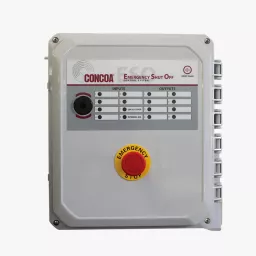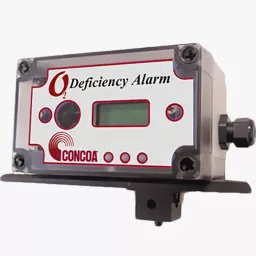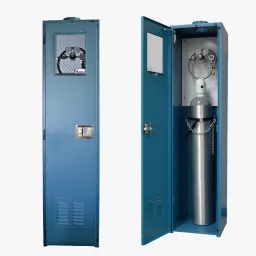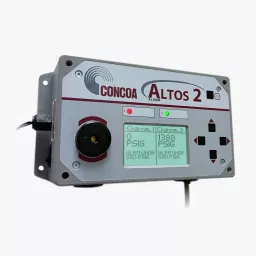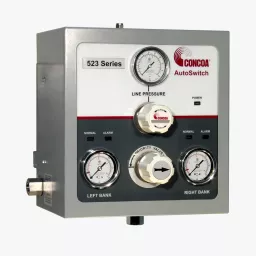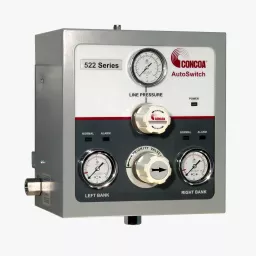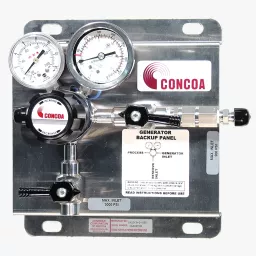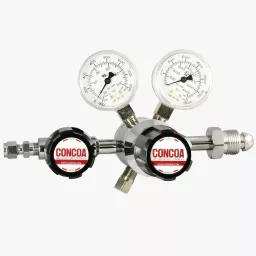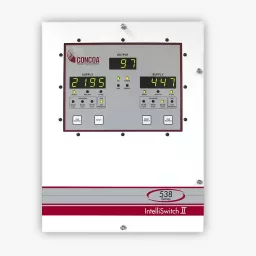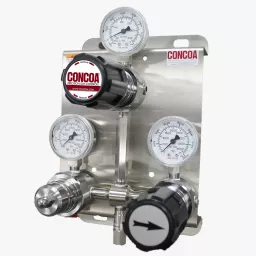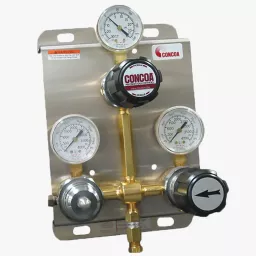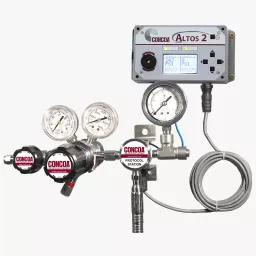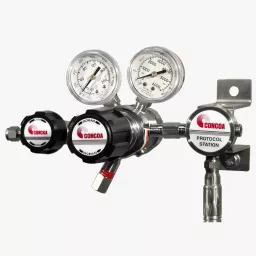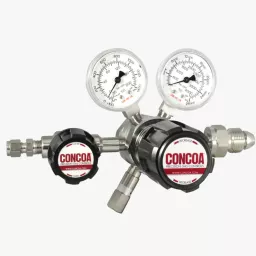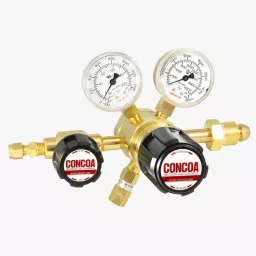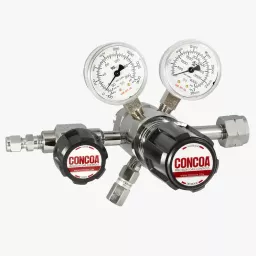Gas chromatography (GC) is an analytical technique that separates compounds in a mixture to identify its components. Because of its speed, versatility, and accuracy in analyzing sample types, GC plays a vital role in many industries and applications.
Gas chromatography-mass spectrometry (GC-MS) combines a gas chromatograph – which vaporizes a sample into a gas phase and separates it into various components – with a mass spectrometer, which breaks components into ionized fragments and measures the intensity of each ion. Because carrier gas impurities can negatively affect the performance and accuracy of the analysis, GC-MS uses high purity carrier gases such as helium, nitrogen, or argon to carry samples. Using GC-MS, both quantitative and qualitative analysis of samples can be performed, which positively identifies the presence of different substances.
For smaller GC-MS applications, the economical 312 Series regulator with chrome-plated brass barstock body, 1 x10⁻⁸ scc/sec helium leak integrity, and 316L stainless steel diaphragm prevents diffusion and off-gassing impurities into the gas stream and provides smooth, clean surfaces that ensure contaminants do not threaten the application. These chrome-plated brass regulators are suitable for the high-purity and ultra-high purity carrier gases used in sensitive GC-MS applications. They feature very low internal dead volume relative to the forged brass body of a 200 Series regulator. Additionally, two stages of pressure regulation provide constant pressure control and stable delivery pressure regardless of supply pressure variations. For applications using research grade or 99.9999% purity carrier gases, CONCOA recommends the 400 Series regulator. The 411, 412, or the all-stainless steel 432 regulator provides 1x10⁻⁹ scc/sec helium leak integrity, the same barstock body, and 316L stainless diaphragm but with metal-to-metal diaphragm seals, which is preferred when analyzing in the parts per billion or parts per trillion ranges. Adding a 529 Series protocol station or a 529 protocol alarm station permits wall mounting or connection to multiple cylinders of the same gas. Another option is the 526 or 527 Series pressure differential switchover. CONCOA automatic switchovers provide a continuous supply of gas at constant pressure, safely and efficiently, from two separate banks of cylinders, thereby reducing the handling of gas cylinders.
For laboratories running GC-MS operations continuously, the fully automatic CONCOA 538 or 539 Series IntelliSwitch system, with electronic look-back and economizer technology, offer 97% primary cylinder utilization and 0% secondary cylinder vent loss. The 539 Series IntelliSwitch II also features proprietary web server technology allowing remote monitoring, secure system configuration, and real-time email notification and updates. CONCOA 54 Series point-of-use panel with 400 Series regulators, with optional gas filters or flashback arrestors, offer high purity final line regulation. For laboratories generating carrier gas on-site, the CONCOA 540 Series back-up panel can prevent planned or unplanned supply interruption.
Other gas chromatography detection methods, such as flame ionization detectors (FID) or flame thermionic detectors (FTD), may require flammable or corrosive detector or makeup gases. These include hydrogen, methane, ammonia, and gas mixtures, such as P5 (5% methane-balanced argon), or P10 (10% methane-balanced argon). For GC detection applications using flammable gases, CONCOA recommends the brass 522 Series AutoSwitch, the stainless steel 523 Series AutoSwitch with transducers and intrinsic safety barriers, or the 526 Series switchover with brass barstock regulator and brass components. For research grade or 99.9999% purity support gases, the 527 Series switchover with 316L stainless steel barstock regulator and components minimizes the risk of system contamination. With the 526 or 527 Series switchovers, CONCOA strongly recommends an integrated C-Series gas cabinet system configured with automated safety control features such as gas detection, remote alarm, excess flow switch, and emergency shutdown controller to meet safe storage requirements of flammable or hazardous gases within the facility.
For GC detection requiring the use of corrosive gases, gas consumption is typically less, and either the 527 Series pressure differential switchover with stainless steel regulator and components or a 422 or 432 Series single source regulator may be used. These can be integrated into a CONCOA C-Series half-size shorty gas cabinet. This allows the system to occupy a small space while providing containment and protection from exhaust, as required with toxic and corrosive gases such as ammonia.
Other gas chromatography detection methods, such as flame ionization detectors (FID), thermal conductivity detectors (TCD), barrier discharge ionization detectors (BID), and electron capture detectors (ECD), require a detector gas based on its principle of detection and may require an additional makeup gas. These gases include hydrogen, methane, ammonia, and gas mixtures, such as P5 (5% methane-balanced argon), or P10 (10% methane-balanced argon). For GC detection methods that require the use of flammable detector and/or makeup gases, CONCOA recommends the 522 or 523 Series AutoSwitch with transducers and intrinsic safety barriers, or the 526 or 527 Series automatic switchover. These automatic switchover systems are designed to interface with CONCOA's Altos 2 remote alarm to provide audible and visible alerts before a switchover occurs. With flammable gases, utilizing the remote alarm option requires the use of intrinsic safety barriers. In addition, CONCOA recommends an integrated C-Series Gas Cabinet System configured with automated safety control features such as gas detection, remote alarm, excess flow switch, and emergency shutdown controller for safe and compliant use with flammable gas within the laboratory.
Modern chemical and forensic research relies on gas chromatography to separate compounds for further analysis. CONCOA’s 526 and 527 Series Switchovers provide an uninterrupted supply of traditional inert carrier gases such as nitrogen or helium. C-Series Gas Cabinet Systems allow safe and compliant use of hydrogen within the laboratory. If the carrier gas is generated on site, a 540 Series Back-Up Panel can prevent planned or unplanned supply interruption. 54 Series Point-of-Use Panels with 400 Series regulators, optionally including gas filters or flashback arrestors, offer high-purity final line regulation in the laboratory. CONCOA's full line of pressure control supply systems allows you to outfit your entire GC operation with the most reliable equipment available today.

